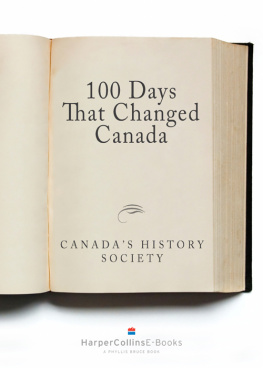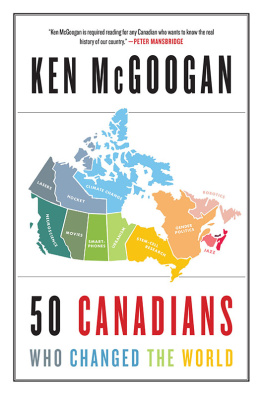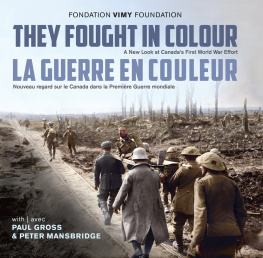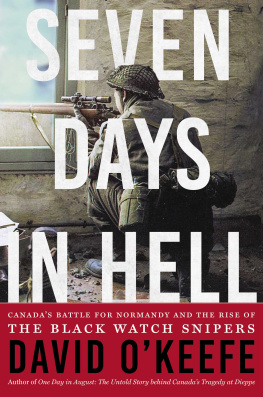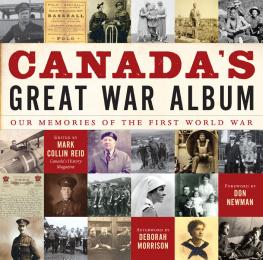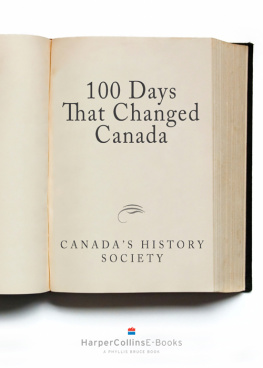CANADA
HISTORY
100
DAYS
THAT CHANGED
CANADA
EDITED BY MARK REID,CANADAS HISTORY MAGAZINE
FOREWORD BY CHARLOTTE GRAY
PREFACE BY DEBORAH MORRISON

Contents

Valberg Imaging
FOREWORD
CHARLOTTE GRAY
I love exploring photo albums. I treasure my own family albums, in which are glued pictures of long-dead relatives and of my three sons (now adults) as small boys, and I am enthralled by leather-bound scrapbooks that I find in archives when researching my books. Everything about such collections intrigues methe dusty smell of the old volumes, the unexpected images that challenge my memories, the reminders that todays world is the result of all those yesterdays.
In photographs, you come face to face with the past. A young womans excitement in 1946 as she arrives as a war bride in Canada or the anger of demonstrators at Torontos G20 protests in 2010 is almost palpable. Photographs offer vivid evidence of events that made our history change direction, and of emotions that have driven Canadians to great accomplishments or personal triumphs. They remind us of the breadth of the Canadian experience. What would canada be like today if there had been no transcontinental railway, no tim hortons, no Quebec nationalism, no giller Prize?
The history of canada has always been too complex, too multilayered to shoehorn into one national narrative. historians of previous generations tried their best to do so, in textbooks that told the story of national elites who passed laws, built railroads, policed the West, and ran the country. Portraits of the bewhiskered heroes of this narrative, with British or French names, still line the walls of our legislatures. But there is so much more to the story, and there are other groups demanding and deserving their place in our history.
As you make your way through the days we have chosen for this album, you will see the rough outline of a larger and more interesting picture emerge. you will see the dominance of those bewhiskered patriarchs toppled as new groups claimed their place in the mainstreamwomen, francophones, First nations, northerners, immigrants. thats what makes this collection of essays such a thrilling way to explore our collective past. My family albums recall for me different chapters in my own life; 100 Days That Changed Canada reminds me of the dozens of stories that flow alongside one another, or blend together, or meet in a mighty roar of whitewater in our national history.
In 1867 canada was a poor and sparsely populated land dependent on agricultural exports. steeped in the ideology of imperialism, it was one smear of pink within the larger British empire. today we live in one of the wealthiest countries in the world, which boasts a robust economy fuelled by scientific and business achievements. this is not always a sunny tale of unalloyed progress: during these years, our politics have become more antagonistic and our society is perhaps more fractured. But there is a strong sense of national identity (think of the coast-to-coast euphoria produced by the 2010 Vancouver Olympics!) and a confidence in our countrys stability. In 100 Days That Changed Canada, we show you some of the people and events that have made us the way we are.

Marianne Helm
PREFACE
DEBORAH MORRISO
W eve all experienced moments when something suddenly causes a fundamental shift in our thinking. It could be the moment you fall in love; the moment the company you work for makes a new acquisition; or, as in Egypt in early 2011, the moment you believe that protest will lead to revolution. Canadian writer Malcolm Gladwell calls these moments tipping points. They come upon us unexpectedly, and its only with the opportunity to look back on what happened that we begin to understand how and why they were able to cause significant change.
Gladwell suggests that tipping points require two things: an idea and a means to communicate it. With each generation, the rate of change has risen exponentially. Ideas can come from anywhere, and todays technologies allow them to spread widely and rapidly. Change is no longer simply constantits compelling. As individuals and as a society, we can no longer simply embrace change. We need to anticipate it, and in some respects, drive it.
The idea behind this book is a good example. In 2008, Mark Reid was inspired to create a feature story for The Beaver (now called Canadas History) magazine using photographs as an innovative approach to talking about key moments in our history. The magazine article sparked an exhibition at Library and Archives Canada, and then a publishing partnership with HarperCollins Canada. 100 Photos That Changed Canada became the best-selling history book in Canada for 2009, giving us the confidence to present you with this newest one.
Canadas History Society strives to create these types of tipping points all the time. We began in 1920 with our flagship magazine, The Beaver, which today, published as Canadas History, is the second-oldest consumer magazine in the country. Weve developed childrens programming with Kayak: Canadas History Magazine for Kids, the Kayak Kids Illustrated Story Challenge, and Heritage Fairs. The Governor Generals Awards for Excellence in Teaching History have precipitated a number of initiatives to share lesson plans and teaching strategies, as well as to create curriculum-linked resources using the contents of our magazines. Through Canadas History Awards weve developed partnerships with other leading history organizations. Most recently, weve launched CanadasHistory.ca, a dynamic new web portal where all sectors of the history community converge. Canadians can now retrieve and comment on news and events in the field of history, academic research, genealogy advice, and travel tips.
Although celebrating our stories remains at the core of what we do, the role that Canadas History plays has shifted from magazine publisher to community service provider. Canadas History has become what Malcolm Gladwell described as the connector with the past, creating the entry points for all Canadians to see themselves in our national story.
A project like 100 Days That Changed Canada provides us with a hundred tipping points, and a hundred stories about those moments. We hope it will spark an interest to share your own story, or to discover others. Together we can create thousands more. The dialogue continues online at CanadasHistory.ca. We hope to see you there!

Marianne Helm
INTRODUCTION
MARK REID
I n the early spring of 1977, an eighteen-year-old Vancouver man received the worst news he could have expected.
Handsome and athletic, Terry Fox had plenty going for him. He came from a tight-knit family and was taking courses toward a kinesiology degree at Simon Fraser University. He had recently visited a doctor to complain of soreness in his leg. It was a nagging pain that just wouldnt go awaymore frustrating than anything, as it hampered him when he played sports. Terry thought it was probably nothing. But on March 2, 1977, the doctor told him that he was actually suffering from osteosarcomacancer of the bone.
Next page
